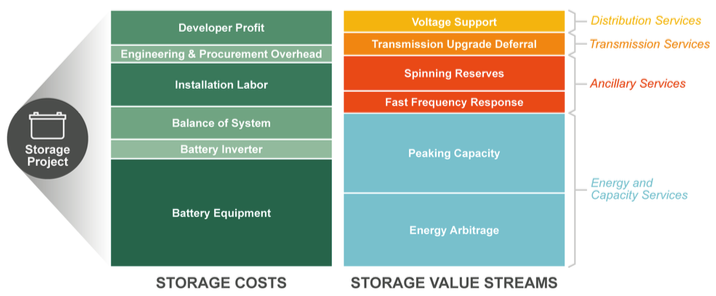Storage as a Grid Solution
Summary for Decision Makers
To increase flexibility, reliability, and resiliency of power systems, decision makers need to consider a suite of tools, with energy storage being just one of those tools. When considering a decision to invest in energy storage, it is important to consider the technical and economic merit of a wide array of options that can lead to a least-cost and no-regrets portfolio of grid solutions. This can be done though grid integration studies conducted using a variety of established methods. It is also important to maximize the value offered by the variety of storage services, while prioritizing reliability.
What are Suitable Methods for Grid Integration Studies?
Capacity expansion models (CEM) create technically sound, least-cost investment plans for the power system to meet demand and reliability constraints over time by creating scenarios of cost-optimal portfolios of the future mix of generation, storage, and transmission capacity expansion. Multiple future scenarios are then used as a baseline for more detailed production cost models (PCM). However, because CEMs examine questions of optimal investment over long periods, they are limited in their ability to characterize the short-term flexibility and reliability attributes of grid solutions.
PCMs simulate the technical and economic operation of the power system—typically for a period of 1 year—and can characterize the flexibility and reliability attributes of various grid solutions with relative accuracy, from timescales of minutes to months. This makes PCMs a powerful tool to compare the operational value of various grid solutions, including storage.
Power flow models (PFMs) are used to simulate the physical movement of electricity through the power system during both normal steady-state operations and during periods of system stress. For the purposes of comparing grid solutions, PFMs are an important tool for validating the technical feasibility of portfolios of grid solutions from CEM and PCM analyses. Given the high granularity of PFMs and related tools, they are typically only used to analyze a snapshot (of up to several minutes) of power system operations.
Avoided network infrastructure valuation assessments help grid operators compare costs between “non-wires alternative” grid solutions, like storage, and traditional network infrastructure investments in locations where existing network capacity is not sufficient to meet expected electricity demand. This approach can be used to create a cost savings metric associated with each NWA that can help inform investment decisions.
Project-level techno-economic assessments are used to design individual grid solutions and characterize their expected technical operation and financial performance, most used by project developers. Policymakers and regulators also use these tools to evaluate projects and benchmark contract prices for proposals received from utilities and/or the private sector, and to design new forms of DER compensation to understand the customer economics implications of new schemes. An example of these tools is NREL’s System Advisor Model.
End-use adoption models, such as NREL’s dGen tool, can provide an estimate of the levels of DER investment that are likely to occur in each region and time. Such models can also relate important information on how certain factors like cost reductions, compensation mechanisms and other policy interventions are likely to impact when and where BTM storage will be adopted.
What Services Can Storage Provide?
The figure below shows the categories of system services that can be provided by grid-connected energy storage systems. Importantly, these potential services are provided over different timescales. Some power system issues require near-immediate service provision to be addressed, whereas others might be resolved over the course of hours, days, or even seasons. The duration of an energy storage device often determines which services it can provide, as detailed on the Energy Storage Technologies page <hyperlink to previous page> of this guidebook.

What is Value Stacking?
Value stacking is a multi-use approach to help improve overall energy storage utilization and the economics of energy storage projects by maximizing value for providing a range of services, rather than just a narrow subset. However, the higher utilization from value stacking may lead to faster degradation in energy storage systems, as they are dispatched more often than if they only provided a narrow set of services. Despite the cost benefits of value stacking, it is important prioritize critical reliability services and consider technical constraints when evaluating and designing the appropriate storage system.


